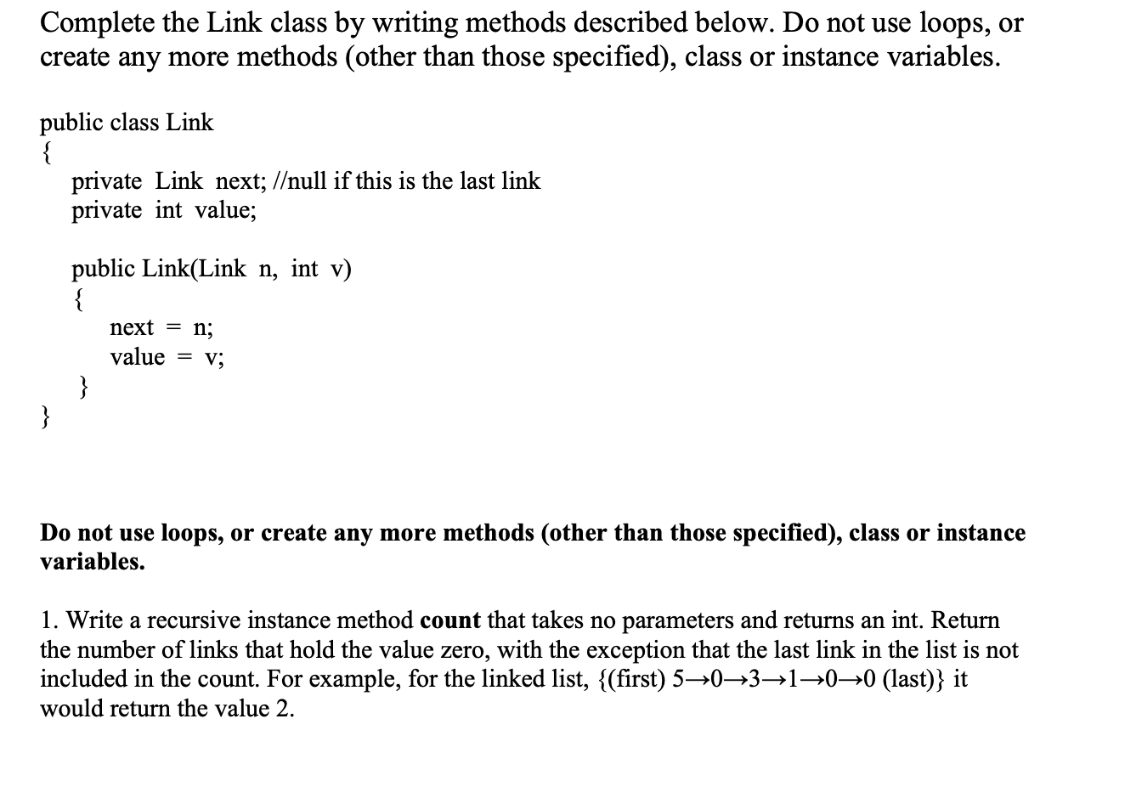Complete the Link class by writing methods described below. Do not use loops, or create any more methods (other than those specified), class or instance variables. public class Link { private Link next; //null if this is the last link private int value; public Link(Link n, int v) { next = n; value = v; } Do not use loops, or create any more methods (other than those specified), class or instance variables. 1. Write a recursive instance method count that takes no parameters and returns an int. Return the number of links that hold the value zero, with the exception that the last link in the list is not included in the count. For example, for the linked list, {(first) 5–→0→3→1→0→0 (last)} it would return the value 2.
Complete the Link class by writing methods described below. Do not use loops, or create any more methods (other than those specified), class or instance variables. public class Link { private Link next; //null if this is the last link private int value; public Link(Link n, int v) { next = n; value = v; } Do not use loops, or create any more methods (other than those specified), class or instance variables. 1. Write a recursive instance method count that takes no parameters and returns an int. Return the number of links that hold the value zero, with the exception that the last link in the list is not included in the count. For example, for the linked list, {(first) 5–→0→3→1→0→0 (last)} it would return the value 2.
Database System Concepts
7th Edition
ISBN:9780078022159
Author:Abraham Silberschatz Professor, Henry F. Korth, S. Sudarshan
Publisher:Abraham Silberschatz Professor, Henry F. Korth, S. Sudarshan
Chapter1: Introduction
Section: Chapter Questions
Problem 1PE
Related questions
Question

Transcribed Image Text:Complete the Link class by writing methods described below. Do not use loops, or
create any more methods (other than those specified), class or instance variables.
public class Link
private Link next; //null if this is the last link
private int value;
public Link(Link n, int v)
{
next = n;
value = v;
}
}
Do not use loops, or create any more methods (other than those specified), class or instance
variables.
1. Write a recursive instance method count that takes no parameters and returns an int. Return
the number of links that hold the value zero, with the exception that the last link in the list is not
included in the count. For example, for the linked list, {(first) 5→0→3→1→0→0 (last)} it
would return the value 2.
Expert Solution
This question has been solved!
Explore an expertly crafted, step-by-step solution for a thorough understanding of key concepts.
This is a popular solution!
Trending now
This is a popular solution!
Step by step
Solved in 2 steps with 1 images

Recommended textbooks for you

Database System Concepts
Computer Science
ISBN:
9780078022159
Author:
Abraham Silberschatz Professor, Henry F. Korth, S. Sudarshan
Publisher:
McGraw-Hill Education

Starting Out with Python (4th Edition)
Computer Science
ISBN:
9780134444321
Author:
Tony Gaddis
Publisher:
PEARSON

Digital Fundamentals (11th Edition)
Computer Science
ISBN:
9780132737968
Author:
Thomas L. Floyd
Publisher:
PEARSON

Database System Concepts
Computer Science
ISBN:
9780078022159
Author:
Abraham Silberschatz Professor, Henry F. Korth, S. Sudarshan
Publisher:
McGraw-Hill Education

Starting Out with Python (4th Edition)
Computer Science
ISBN:
9780134444321
Author:
Tony Gaddis
Publisher:
PEARSON

Digital Fundamentals (11th Edition)
Computer Science
ISBN:
9780132737968
Author:
Thomas L. Floyd
Publisher:
PEARSON

C How to Program (8th Edition)
Computer Science
ISBN:
9780133976892
Author:
Paul J. Deitel, Harvey Deitel
Publisher:
PEARSON

Database Systems: Design, Implementation, & Manag…
Computer Science
ISBN:
9781337627900
Author:
Carlos Coronel, Steven Morris
Publisher:
Cengage Learning

Programmable Logic Controllers
Computer Science
ISBN:
9780073373843
Author:
Frank D. Petruzella
Publisher:
McGraw-Hill Education